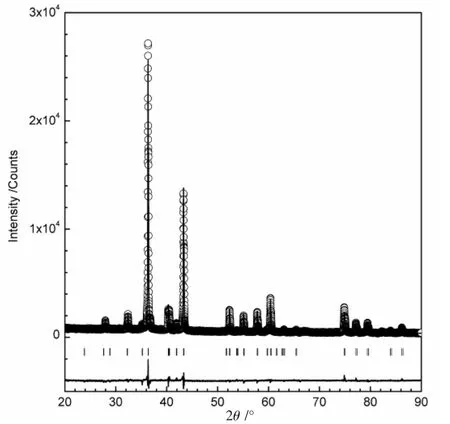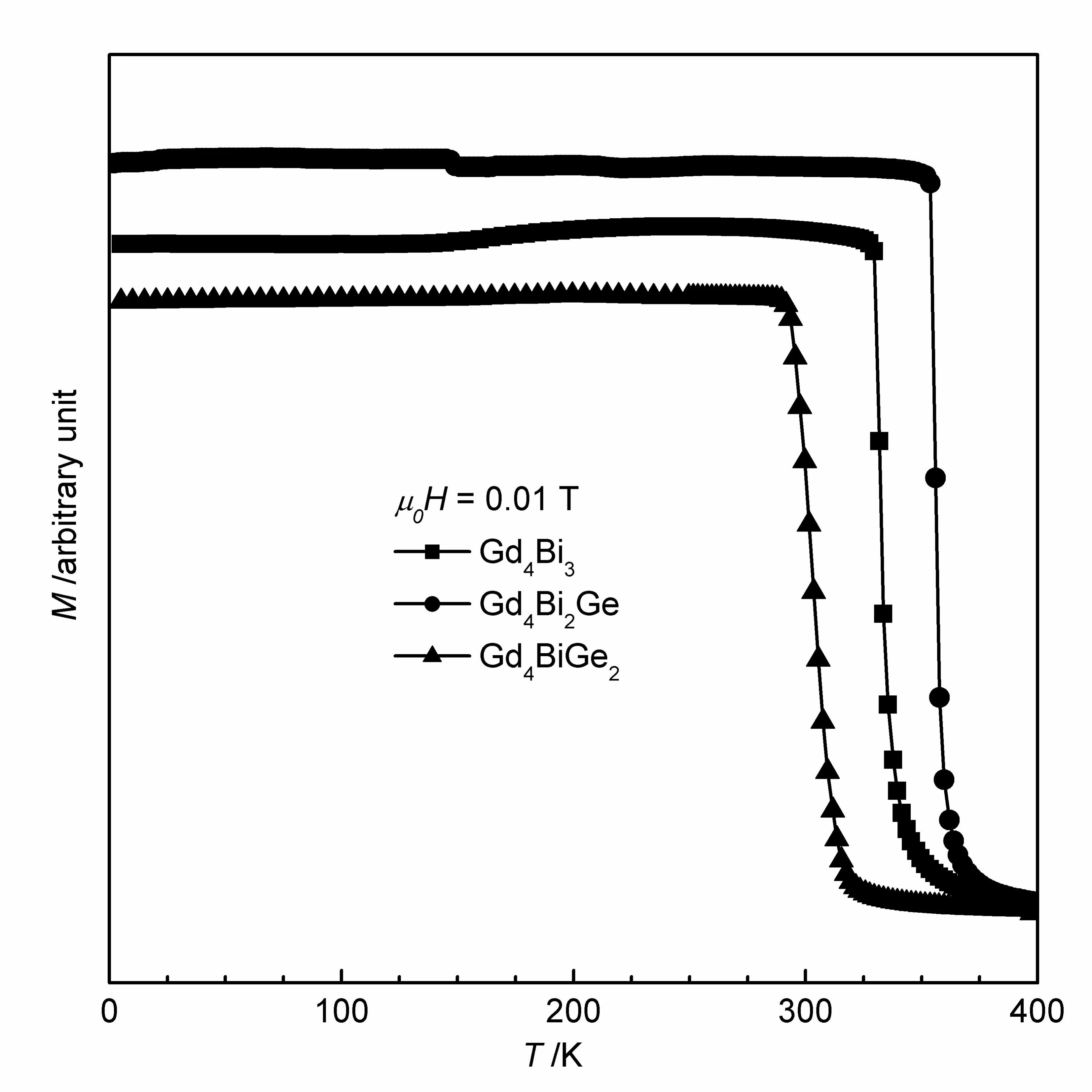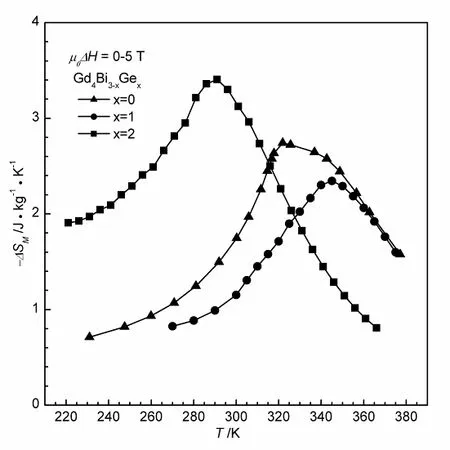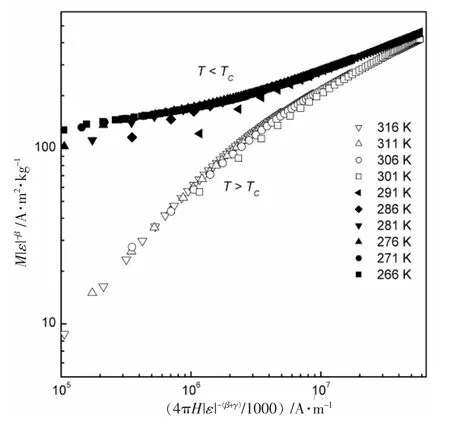Room temperature magnetocaloric effect of Gd4(Bi,Ge)3 compound
ZHU Yutao,MA Chunlan,YAO Jinlei
(School of Mathematics and Physics,SUST,Suzhou 215009,China;Jiangsu Key Laboratory of Micro and Nano Heat Fluid Flow Technology and Energy Application,Suzhou 215009,China)
Abstract: The phase pure Gd4Bi3-xGex(x=0,1 and 2) polycrystalline compounds were prepared by arc melting and subsequent annealing.Gd4Bi3-xGex adopts the cubic anti-Th3P4 structure(space group I-43d),and its lattice parameter a decreases from 0.939 93(2) nm of x=0 to 0.906 97(2) nm of x=2.The Curie temperature TC is respectively 327,350 and 296 K respectively for x=0,1 and 2 determined by the Arrott method.Gd4Bi3-xGex has the maximum magnetic entropy change of 2.7,2.3 and 3.4 J·kg-1·K-1 and the relative cooling power of 257,184 and 442 J·kg-1 for x=0,1 and 2,respectively,around TC in a field induction variation of 5 T.The critical magnetization behavior near TC follows the scaling theory,and the field dependence of magnetization can be described as two distinct regular functions above and below TC.Long range magnetic interactions dominate the magnetization behavior of Gd4BiGe2 in the vicinity of ferromagnetism-paramagnetism transition in the mean field model.
Key words: magnetocaloric effect;magnetic entropy change;rare earth compound;scaling hypothesis;critical behavior
Magnetic refrigeration is an environmental friendly cooling technology with a high cooling efficiency,a promising alternative to the conventional vapor cycle refrigeration[1].It utilizes the large magnetocaloric effect(MCE) of magnetic materials with the first- or second-order magnetic transitions.MCE materials with the firstorder transition includes Gd5(Si,Ge)4[2],La(Fe,Si)13[3],MnFe(P,As)[4]and Heusler alloys[5].They exhibit the giant MCE,but a large magnetic hysteresis,reducing the cooling capability.On the other hand,MCE materials with the second-order transition have a negligible hysteresis and large MCE,which is suitable for being active magnetic refrigerant.The typical materials have Gd metal and perovskite manganites[2,6].However,their magnetic ordering temperatures are usually below room temperature varing in a narrow temperature interval.For instance,the Curie temperature (TC) of Gd is 294 K and the substitution of other rare earth atoms decreases TC,limiting the applications around room temperature[1].TCcan be enhanced by means of alloying Gd with main group elements.Gd4Bi3is such a ferromagnet with high TC=335 K[7].Here,we demonstrate that TCof Gd4Bi3can be tuned in a wide temperature range around room temperature by the element substitution,accompanying with a relatively large refrigeration capability.
1 Experimental details
The Gd4Bi3-xGex(x=0,1 and 2)ingots were prepared by arc-melting stoichiometric amounts of Gd(99.99 wt%),Bi(99.998 wt%) and Ge(99.999 9 wt%) under an argon atmosphere on a water-cooled copper hearth.Due to the high vapor pressure of Bi,an excess of 10 wt% Bi was loaded to compensate for the weight loss during arc melting.The cast samples were wrapped in Ta foils,sealed in evacuated silica tubes,annealed at 1 373 K for 1 week,and finally quenched in ice-cold water.
The powder X-ray diffraction (XRD) patterns of annealed samples were collected on a PANalytical X’Pert Pro diffractometer using the Co Kαradiation.Phase analyses were carried out by Rietveld refinements on the XRD data using Rietica[8].The magnetization (M) measurements were performed on a Quantum Design physical property measurement system as in Ref[9].MCE in terms of isothermal entropy change,△SM,was calculated from isothermal magnetization vs.field (M vs.μ0H) data around TCthrough the well-known Maxwell equation[10].
2 Results and discussion
The powder XRD data of Gd4Bi3-xGexshow that the samples have the dominant phase with the cubic anti-Th3P4structure (space group I-43d)and a minority Gd5(Bi,Ge)3phase.The structural studies of Gd4Bi3-xGexcrystals revealed that the anti-Th3P4phase can survive up to x=2.5[11],in accordance with the single phase of our studied samples.The Rietveld refinement on the XRD pattern of x=2 in Figure 1 confirmed that Gd4BiGe2is phase pure with the lattice parameter a=0.906 97 (2) nm and volume V=0.746 07(3) nm3.The refined lattice parameters of other two samples are also gathered in Table 1.One can see that the unit cell shrinks from V=0.830 40(3) nm3of x=0 to V=0.746 07(3) nm3of x=2 with the substitution of Ge for Bi,due to the smaller ionic radius of Ge than Bi,i.e.,r(Ge4-)=0.053 nm<r(Bi3-)=0.103 nm[12].
Figure 2 displays the thermal magnetization curves of Gd4Bi3-xGexfrom 2 K to 400 K in a magnetic field μ0H of 0.01 T.It shows that all three samples are ferromagnetic below TC,and paramagnetic higher than TCwhich is estimated as a minimum on the dM/dT curve usually.The samples with x=0,1 and 2 have TCat 332 K,355 K and 301 K,respectively,in good agreement with the reported TCfor Gd4Bi3-xGex[11].As expected,the Ge substitution can turn the magnetic ordering temperature in a wide range around room temperature,which is im-portant for practical applications of magnetic refrigeration.

Figure 1 Rietveld refinement of Gd4BiGe2 XRD data (Rp=4.42%,Rwp=5.75% and GOF=2.47)

Table 1 Lattice parameters and magnetic data of Gd4Bi3-xGex

Figure 2 Temperature dependence of magnetization for Gd4Bi3-xGex in a magnetic field μ0H of 0.01 T
In order to determine the accurate value of TCfor Gd4BiGe2,we measured the M-H curves every 1 K around 301 K which were then converted to the Arrott plots (M2vs.μ0H/M) shown on Figure 3.According to the Arrott method[13],the isothermal M2-μ0H/M curve in high magnetic field at TCpasses through the origin.The linear fit on Figure 3 suggests TC=296 K for Gd4BiGe2.The same way applying to Gd4Bi3and Gd4Bi2Ge yielded TCat 327 K and 350 K,respectively,which is listed in Table 1.They are slightly lower than the temperatures of dM/dT mini mum.Moreover,the order of magnetic transition can be determined using the Banerjee criterion[14].The transition is of first order in case that the Arrott plots show a negative slope,whereas it belongs to the second order transition when the Arrott plots have a positive slope.For Gd4BiGe2,the M2-H/M curves exhibit positive slopes,indicating the second order nature of the ferromagnetism-paramagnetism transition.
To evaluate MCE,-△SMcan be derived from the isothermal magnetization curves in the vicinity of TC.Take Gd4BiGe2for an example,the magnetization as a function of magnetic field was recorded from 221 K to 371 K with a step of 5 K shown in Figure 4.The M-μ0H curves lower than TC=296 K display tendency to saturation in fields up to 5 T,suggesting a ferromagnetic state.The temperature dependence of -△SMfor Gd4BiGe2in a field change of 0~5 T is shown on Figure 5,and it reaches the maximal -△Smax=3.4 J·kg-1·K-1at 291 K.Except for the magnitude of -△Smax,another important parameter to assess the efficiency of a magnetocaloric material is the relative cooling power (RCP),which is a measure of how much heat can be transferred between the cold and the hot sinks in an ideal refrigeration cycle.The magnitude of RCP is approximated as

where △TFWHMis the full-width temperature span at the half-maximum of -△SMversus T curve[15].

Figure 3 Arrott plots (M2 vs.μ0H/M)for Gd4BiGe2 around the Curie temperature

Figure 4 Magnetic field dependence of magnetization for Gd4BiGe2 from 221 K to 371 K
The calculated RCP values of Gd4Bi3-xGexin a magnetic field variation of 5 T are 257,184 and 442 J·kg-1for x=0,1 and 2,respectively (Table 1).Although -△SM=2.3~3.4 J·kg-1·K-1of Gd4Bi3-xGexis much smaller than Gd metal (-△SM=9.5 J·kg-1·K-1) in a field change of 5 T,its RCP is comparable to Gd with RCP=410 J·kg-1[15].Considering the large RCP with a broad operating temperature range,a negligible hysteresis and small amount of rare-earth content,Gd4Bi3-xGexis a potential working material for magnetic refrigeration around room temperature.
To gain a further insight into the nature of ferromagnetism-paramagnetism transition in the Gd4Bi3-xGexseries,the critical magnetization behavior of Gd4BiGe2near TChave been investigated in detail.According to the scaling hypothesis[16],the critical magnetization isotherm at TCfollows the behavior

A fit to the M-H curve of Gd4BiGe2at TCusing Eq.2 yielded the exponent δ=3.03 (Figure 6).To obtain another critical exponent n,the field dependence of -△SMunder various fields has been depicted in Figure 7.The relationship of the maximum magnetic entropy change -△Smaxand magnetic field can be written as

where n=1+(1-1/β)/δ[17].The values of n=0.75 and β=0.57 of Gd4BiGe2were derived from a fit to the -△Smax-H data by Eq.3 (Figure 6).The critical exponents β,γ and δ are related to each other by the Widom scaling relation[18]

Substituting the derived values of β and δ into Eq.4,we got γ=1.16.The values of critical exponents β,γ and δ are respectively 0.57,1.16 and 3.03 for Gd4BiGe2,close to the mean field model with β=0.5,γ=1 and δ=3[16].It suggests that the long range magnetic interactions dominate the magnetization behavior of Gd4BiGe2in the vicinity of magnetic phase transition.
The reliability of the calculated critical exponents can be justified by the scaling theory[19].Based on the scaling hypothesis,the magnetization near TCis a universal function of temperature and magnetic field

where the reduced temperature ε=(T-TC)/TC,and f+and fare respectively regular analytical functions higher and lower TC.Using the obtained values of β and γ above,the M|ε|-βverses H|ε|-(β+γ)plots at various temperatures collapse into two universal curves,one for temperatures above TCand the other for temperatures below TCshown on Figure 8,in accordance with the scaling theory.It indicates the critical exponents obtained from field dependence of magnetization and -△Smaxare reasonable accurate.This universal relationship provides a tool to design working materials under various conditions for magnetic refrigeration.
3 Conclusion

Figure 5 Temperature dependence of magnetic entropy change -△SM of Gd4Bi3-xGex in a magnetic field change of 5 T

Figure 6 Field dependence of magnetization and magnetic entropy change for Gd4BiGe2 at Curie temperature.The open symbols are the experimental data and the solid lines are the fits by Eqs.(2)and (3)

Figure 7 Temperature dependence of magnetic entropy change -△SM of Gd4BiGe2 in various magnetic field changes
In summary,the magnetic ordering temperature of Gd4Bi3can be tuned in a wide temperature range around room temperature.The ferromagnetism -paramagnetism transition is of second order revealed by the Arrott method.The magnetization interactions in the vicinity of TCare long range exchange analyzed through the scaling theory.Gd4Bi3-xGexexhibits the large RCP compared with the Gd metal,as well as a negligible magnetic hysteresis,suggesting a promising refrigerant candidate for magnetic refrigeration around room temperature.

Figure 8 Logarithmic scaling plot of M|ε|-β verses H|ε|-(β+γ)of Gd4BiGe2 in the critical region

